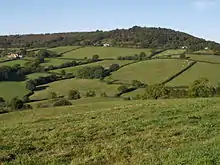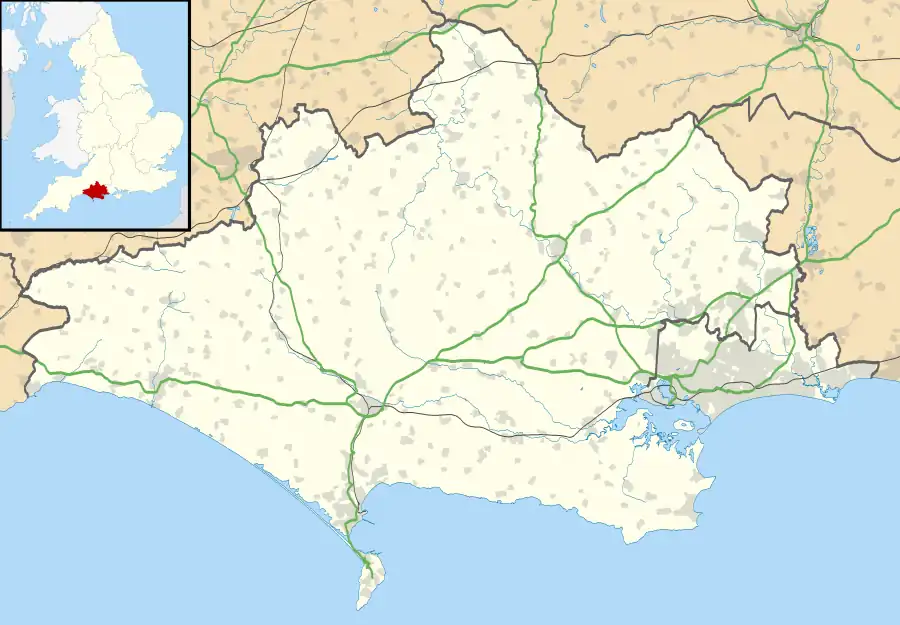Lambert's Castle
Lambert's Castle is an Iron Age hillfort in the county of Dorset in southwest England.[1] Since 1981 it has been designated as a Site of Special Scientific Interest (SSSI) on account of its geology, archaeology and ecology.[2] The hillfort is designated a scheduled monument together with a bowl barrow, the sites of a post-medieval fair and a telegraph station.[3] The site was on the Heritage at Risk Register but was removed in 2022 as a result of the Hillforts and Habitats Project.[4]

 Lambert's Castle, seen from the east | |
 Location of the site in Dorset | |
| Location | Dorset, England |
|---|---|
| Coordinates | 50.78713°N 2.89509°W |
| History | |
| Periods | Iron Age |
| Site notes | |
| Ownership | National Trust |
| Public access | Yes, Open Access Land |
| Official name | Lambert's Castle: an Iron Age hillfort 425m west of Nash Farm, with a bowl barrow, and the sites of a post-medieval fair and a telegraph station |
| Designated | 26 August 1924 |
| Reference no. | 1017035 |
The hillfort is situated on a broad northerly spur at the summit of Lambert's Castle Hill, which rises to a height of 256 metres (840 ft). There are steep natural slopes on three sides of the fort, and linear ramparts across the flat southern approaches. The site is owned by the National Trust. A car park is accessible from the B3165 road. There are two other hill-forts near Lambert's Castle: Coney's Castle is about 1.5 kilometres (0.9 mi) to its south, and Pilsdon Pen is about 5 km (3.1 mi) to its north-east.
History
Lamberts Castle was built around 2,500 years ago; a prominent ditch and bank still survive near the western entrance. A fair was held here from 1709 to 1947, during which the hilltop was used as a racecourse.[1]
Geology
The site consists of sands and marls of the middle Lias with the remains of Gault and Upper Greensand capping. There are strong outflows of springs at various junctions of the upper greensand and gault.
Ecology
Plateau surface of Upper Greensand
This is a mosaic of acidic grassland, open heath, scrubland and secondary woodland and comprises: sheep-fescue (Festuca ovina), sweet vernal-grass (Anthoxanthum odoratum), early hair-grass (Aira praecox), heath-grass (Danthonia decumbens) and field wood-rush (Luzula campestris). Herbs present include abundant tormentil (Potentilla erecta), heath milkwort (Polygala serpyllifolia), cats-ear (Hypochaeris radicata), heath bedstraw (Galium saxatile), heather (Calluna vulgaris), bell heather (Erica cinerea), bristle bent (Agrostis curtisii), bilberry (Vaccinium myrtillus), bryophytes, lichen, gorse (Ulex europaeus), western gorse (Ulex gallii), bramble (Rubus fruticosus), bracken (Pteridium aquilinum), birch (Betula spp.), hawthorn (Crataegus monogyna), rowan (Sorbus aucuparia) and pedunculate oak (Quercus robur).
Upper Greensand / Gault junction
A zone of acidic bog vegetation consisting of: purple moor-grass (Molinia caerulea), common cottongrass (Eriophorum angustifolium), sedges (Carex spp.) including star sedge (Carex echinata), green-ribbed sedge (Carex binervis) and flea sedge (Carex pulicaris); bog moss (Sphagnum spp.), heath spotted-orchid (Dactylorhiza maculata), devils-bit scabious (Succisa pratensis), bog asphodel (Narthecium ossifragum), marsh violet (Viola palustris), meadow thistle (Cirsium dissectum), wood horsetail (Equisetum sylvaticum), lesser butterfly-orchid (Platanthera bifolia) and pale butterwort (Pinguicula lusitanica).
Lower slopes
Unimproved, herb-dominated neutral grassland consisting of: crested dogstail (Cynosurus cristatus), common knapweed (Centaurea nigra), red fescue (Festuca rubra), yellow oat-grass (Trisetum flavescens), quaking grass (Briza media), spring-sedge (Carex caryophyllea), glaucous sedge (Carex flacca), red clover (Trifolium pratense), ox-eye daisy (Leucanthemum vulgare), common bird-foot-trefoil (Lotus corniculatus). Less frequent species are lady's-mantle (Alchemilla vulgaris), dyer's greenweed (Genista tinctoria), corky-fruited water-dropwort (Oenanthe pimpinelloides) and adders-tongue (Ophioglossum vulgatum).
Wet areas in grassland
Soft rush (Juncus effusus), sharp-flowered rush (Juncus acutiflorus), oval sedge (Carex leporina), common yellow-sedge (Carex demissa), carnation sedge (Carex panicea), common marsh-bedstraw (Galium palustre), marsh pennywort (Hydrocotyle vulgaris), ragged-robin (Lychnis flos-cuculi), greater birds-foot-trefoil (Lotus uliginosus), bog pimpernel (Anagallis tenella) and bristle clubrush (Isolepis setacea).
Notable invertebrates
- Glow-worm (Lampyris noctiluca)
- Pearl-bordered fritillary (Boloria selene)
- Small pearl-bordered fritillary (Bolaria euphrosyne)
References
- Lamberts Castle, Dorset: Walk of the week at www.telegraph.co.uk. Accessed on 22 Mar 2013.
- "SSSI detail". designatedsites.naturalengland.org.uk. Retrieved 1 December 2021.
- Historic England. "Lambert's Castle: an Iron Age hillfort 425m west of Nash Farm, with a bowl barrow, and the sites of a post-medieval fair and a telegraph station, Marshwood (1017035)". National Heritage List for England. Retrieved 1 December 2021.
- "'Fine condition': Hillforts no longer 'at risk' after protection work". Bridport and Lyme Regis News. Retrieved 4 April 2022.
External links
- National Trust website
 Media related to Lambert's Castle at Wikimedia Commons
Media related to Lambert's Castle at Wikimedia Commons- SSSI Citation etc from Natural England website